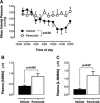Evidence that links loss of cyclooxygenase-2 with increased asymmetric dimethylarginine: novel explanation of cardiovascular side effects associated with anti-inflammatory drugs
- PMID: 25492024
- PMCID: PMC4768634
- DOI: 10.1161/CIRCULATIONAHA.114.011591
Evidence that links loss of cyclooxygenase-2 with increased asymmetric dimethylarginine: novel explanation of cardiovascular side effects associated with anti-inflammatory drugs
Abstract
Background: Cardiovascular side effects associated with cyclooxygenase-2 inhibitor drugs dominate clinical concern. Cyclooxygenase-2 is expressed in the renal medulla where inhibition causes fluid retention and increased blood pressure. However, the mechanisms linking cyclooxygenase-2 inhibition and cardiovascular events are unknown and no biomarkers have been identified.
Methods and results: Transcriptome analysis of wild-type and cyclooxygenase-2(-/-) mouse tissues revealed 1 gene altered in the heart and aorta, but >1000 genes altered in the renal medulla, including those regulating the endogenous nitric oxide synthase inhibitors asymmetrical dimethylarginine (ADMA) and monomethyl-l-arginine. Cyclo-oxygenase-2(-/-) mice had increased plasma levels of ADMA and monomethyl-l-arginine and reduced endothelial nitric oxide responses. These genes and methylarginines were not similarly altered in mice lacking prostacyclin receptors. Wild-type mice or human volunteers taking cyclooxygenase-2 inhibitors also showed increased plasma ADMA. Endothelial nitric oxide is cardio-protective, reducing thrombosis and atherosclerosis. Consequently, increased ADMA is associated with cardiovascular disease. Thus, our study identifies ADMA as a biomarker and mechanistic bridge between renal cyclooxygenase-2 inhibition and systemic vascular dysfunction with nonsteroidal anti-inflammatory drug usage.
Conclusions: We identify the endogenous endothelial nitric oxide synthase inhibitor ADMA as a biomarker and mechanistic bridge between renal cyclooxygenase-2 inhibition and systemic vascular dysfunction.
Keywords: endothelium; kidney; nitric oxide; pharmacology; prostaglandins.
© 2014 The Authors.
Figures





Comment in
-
Letter by Kruszelnicka et al regarding article, "evidence that links loss of cyclooxygenase-2 with increased asymmetric dimethylarginine: novel explanation of cardiovascular side effects associated with anti-inflammatory drugs".Circulation. 2015 Oct 27;132(17):e212. doi: 10.1161/CIRCULATIONAHA.115.015383. Circulation. 2015. PMID: 26503754 No abstract available.
-
Reply to letter regarding article, "evidence that links loss of cyclooxygenase-2 with increased asymmetric dimethylarginine: novel explanation of cardiovascular side effects associated with anti-inflammatory drugs".Circulation. 2015 Oct 27;132(17):e213-4. doi: 10.1161/CIRCULATIONAHA.115.017260. Circulation. 2015. PMID: 26503755 No abstract available.
References
-
- Wallace JL, McKnight W, Reuter BK, Vergnolle N. NSAID-induced gastric damage in rats: requirement for inhibition of both cyclooxygenase 1 and 2. Gastroenterology. 2000;119:706–714. - PubMed
-
- Wallace JL. Prostaglandins, NSAIDs, and gastric mucosal protection: why doesn’t the stomach digest itself? Physiol Rev. 2008;88:1547–1565. doi: 10.1152/physrev.00004.2008. - PubMed
-
- Antman EM, Bennett JS, Daugherty A, Furberg C, Roberts H, Taubert KA American Heart Association. Use of nonsteroidal antiinflammatory drugs: an update for clinicians: a scientific statement from the American Heart Association. Circulation. 2007;115:1634–1642. doi: 10.1161/CIRCULATIONAHA.106.181424. - PubMed
Publication types
MeSH terms
Substances
Grants and funding
LinkOut - more resources
Full Text Sources
Medical
Molecular Biology Databases
Research Materials

